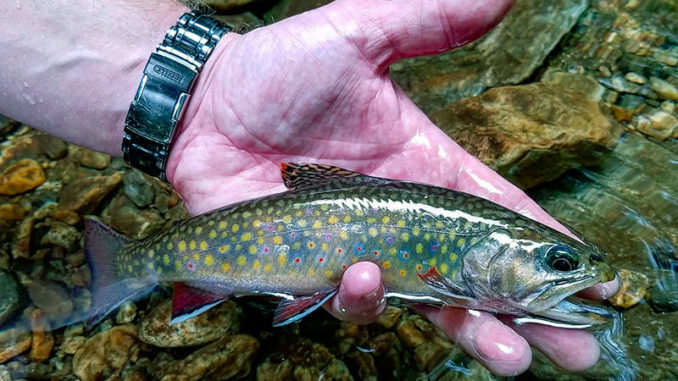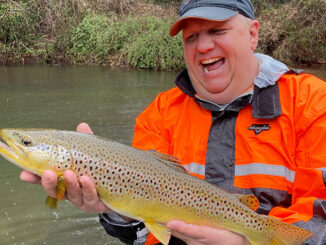
Catch trout in the heat with these tips
When mountain streams are low and clear and temperatures are in the 80s, trout are less active, and catching them requires finesse and patience. Learn how to consistently catch trout in the summer, and you’ll be able to catch them any time of year.
Low, clear water makes trout spooky, especially wild ones. Wear drab clothing, colors that blend in with your surroundings — nothing white or bright, down to your socks. Keep a low profile and fish upstream so trout are less likely to see you coming. Use long leaders, at least 9 feet, and cast from behind rocks or other natural obstructions. If you see fish darting when you move in the water, forget about that stretch of water. No amount of coaxing will result in a strike. Learn your lesson and move on to the next stretch.
Cast close to banks, under low hanging mountain laurel and rhododendron. You’ll lose a few flies and spend an inordinate amount of precious fishing time getting line and flies out of bushes, but that’s part of the fishing experience.
Go for the cool
In hot weather, trout stay in cooler areas of a stream where oxygen content is higher, places that have bubbly, white water, especially little pools below ledges and waterfalls. Let your fly drop naturally into bubbly water or let it drift through riffles. Look for small tributaries that feed cooler water into a main stream. Think like a trout and fish the areas you’d prefer to be in the heat of the day.
Fish smaller streams. The ones with the most cover have the coolest water. Small, high-elevation streams with a heavy canopy can be fished all day. Save the large, open streams for early morning and late evening.
Feed ‘em right
Dry flies. Trout feed during the comfortable times of the day: early morning before the water heats up, and late evening after the water cools down. For dry-fly fishing, these are the most productive times, but sporadic hatches occur all day, only in smaller numbers. For morning dry-fly fishing, Blue-Winged Olive, female or male Adams (winged or parachute), Light Cahill, Tan Caddis and parachute Pheasant Tail are good patterns. Usually a No. 16 or No. 14 works well. For late evening, midges are especially effective in gray, creme, brown or black. Nos. 18 to 22 work best. Some dry-fly patterns, particularly a Cahill or Adams, can be fished all day. Experiment until you get a strike, then stick with that pattern.
Nymphs. Nymph patterns can be fished all day, but they require more skill and patience than dry flies. Strikes can be subtle and difficult to detect unless you’ve done a lot of nymph fishing. Sometimes a strike will be little more than a slight hesitation of the leader. If your nymph fishing is limited, use a commercial strike indicator and attach it to the leader 2 to 3 feet above the fly. A piece of yarn or patch of cotton attached to the leader works just as well as a commercial strike indicator. Watch the indicator as it floats. If it hesitates or moves to one side or the other, raise the tip of your rod. You’ve likely had a strike.
Do double duty

Dry flies also make excellent strike indicators, and they give you an extra edge in the water. Sometimes, a trout will hit the dry fly instead of the nymph. When using a dry fly as a strike indicator, use a section of leader and tie the nymph onto the shank of the main hook and use the nymph as a dropper. If the stream is shallow, the dropper should hang about six inches below the dry fly; 12 inches for deeper water. The nymph should be small enough that it doesn’t drag the dry fly down. If you’re using a No. 14 or No. 16 nymph, for example, use a No. 12 or larger dry fly.
In late summer, a yellow Stimulator or other attractor pattern makes an excellent strike indicator. Suggested nymph patterns for this time of the year are Secret Weapon, Sheep Fly, Pheasant Tail (nymph or emerger), yellow Tellico, and Stone Fly.
Trout love terrestrials
Terrestrials. The ubiquitous bugs of summer — ants, beetles, crickets, grasshoppers, caterpillars, inchworms and bees — provide a constant and substantial food source for trout. Terrestrials can be fished up until the first frost, and they can be fished either wet or dry. Terrestrials usually drop or land in the water with a slight plop, so presentation isn’t a critical factor. Fish them close to banks, around bushes, and anywhere where grass grows along the stream. Fish the sizes closest to the natural thing: a No. 12 up to a No. 10 or No. 8. To get terrestrials such as an inchworm down deep, use a bead-head or tie on extra weight to the leader just above the fly.
Spinning lures such as Rooster Tail, Mepps, Panther Martin and Joe’s Flies all work well for summer fishing. Use smaller lures, 1/16- to 1/8-ounce, in small streams, 1/4-ounce for larger streams.
One effective way to work a spinner is to stand in the middle of a stream and cast in quarter sections, covering as much water as possible. Let the lure sink, then began a slow, steady retrieve. Alternating between a slow and fast retrieve will often cause a trout to strike.





Be the first to comment